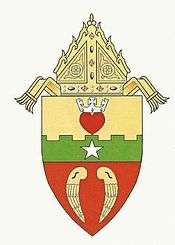Roman Catholic Diocese of San Angelo
| Diocese of San Angelo Dioecesis Angeliana | |
|---|---|
 | |
| Location | |
| Country |
|
| Territory | 29 counties (Central and West Texas) |
| Ecclesiastical province | Archdiocese of San Antonio, Texas |
| Population - Catholics |
82,734 (13.8%) |
| Information | |
| Denomination | Catholic |
| Rite | Roman Rite |
| Established | October 16, 1961 |
| Cathedral | Cathedral of the Sacred Heart |
| Patron saint | St. Michael the Archangel |
| Current leadership | |
| Pope | Francis |
| Bishop | Michael Sis |
| Map | |
 | |
| Website | |
| sanangelodiocese.org | |
The Diocese of San Angelo (Latin: Dioecesis Angeliana) is a Catholic diocese of the Roman Rite covering 29 counties throughout Central and West Texas. It was founded on October 16, 1961. The diocese is a suffragan diocese overseen by the Metropolitan Archdiocese of San Antonio.
On December 12, 2013, Pope Francis named Msgr. Michael J. Sis as the diocese's new bishop, and he was ordained bishop and installed on January 27, 2014.[1]
Description
Encompassing some 37,433 square miles (96,950 km2), the diocese comprises the following 29 counties: Andrews, Brown, Callahan, Coke, Coleman, Concho, Crane, Crockett, Ector, Glasscock, Howard, Irion, Kimble, Martin, McCulloch, Menard, Midland, Mitchell, Nolan, Pecos, Reagan, Runnels, Schleicher, Sterling, Sutton, Taylor, Terrell, Tom Green, and Upton.
Major cities located in the diocese are Abilene, Big Spring, Brownwood, Fort Stockton, Midland, Odessa, San Angelo, and Sweetwater.
History
Prior to 1961, much of the present-day Church was under the jurisdiction of the Diocese of Amarillo. Bishops and priests of that massive lay of land would occasionally be asked to travel great distances — sometimes over 400 miles one way — to visit the southernmost outposts of the West Texas Catholic community. It should go without saying that Church officials, especially those assigned to the Diocese of Amarillo, saw a great need in forming the new diocese in San Angelo.
Pope John XXIII decreed the establishment of the Diocese of San Angelo on October 16, 1961. In addition to Amarillo, some of the land that made up the new diocese was also taken from the dioceses of Austin, El Paso and Dallas-Fort Worth.
"The Church was growing here in a good way, a lot of people were coming into the church and felt it would be good to have a separate diocese," said the Most Rev. Michael D. Pfeifer, OMI, the fifth bishop of the diocese. "Plus, that was an extreme amount of territory for one bishop in Amarillo to cover — it's 450 miles from Amarillo to Junction."
According to Pfeifer, though, it was simply the growth of the Church in West Texas south of Amarillo that necessitated the creation of the diocese.
The need for the new diocese has proved to be expert foresight today, some 50 years later, as the Diocese of San Angelo now numbers over 82,000 Catholics in 47 parishes and 24 missions in three deaneries — San Angelo, Abilene and Midland-Odessa.
Some say the Church's actual roots in West Texas can even be traced back as far as the earliest Spanish explorers who spread the Gospel to Native Americans in the 1500s. Early records do, in fact, show the first sacraments being received by the Jumanos and others at a Mass at the confluence of the Concho rivers in 1629, in what would one day be San Angelo.
The Diocesan See, or headquarters, came to be located in San Angelo, not only for its relative centrality (although somewhere north of Mertzon would be closer to the actual geographic center) but, as legend has it, Pope John XXIII's Italian name was Angelo Roncalli and, looking at a map and seeing a city with his name, the pope so designated San Angelo the See.
"That's where it's going to be," the pope is reported to have said.[2]
Bishops
The list of ordinaries (bishops of the diocese) and their terms of service:
- Thomas Joseph Drury (1961–1965)
- Thomas Ambrose Tschoepe (1966–1969)
- Stephen Aloysius Leven (1969–1979)
- Joseph Anthony Fiorenza (1979–1984)
- Michael David Pfeifer (1985–2013)
- Michael Sis (2014–present)
Other priest of this diocese who became bishop
- Joe Steve Vásquez appointed auxiliary bishop of Galveston-Houston in 2001
See also
| Wikimedia Commons has media related to Catholic Diocese of San Angelo. |
References
- ↑ "Pope Francis names Msgr. Michael J. Sis as new bishop of Diocese of San Angelo, Texas". ncronline.com. Retrieved 12 December 2013.
- ↑ "History | Diocese of San Angelo | San Angelo, Texas". sanangelodiocese.org. Retrieved 2016-06-11.
External links
Coordinates: 31°27′11″N 100°27′09″W / 31.45306°N 100.45250°W